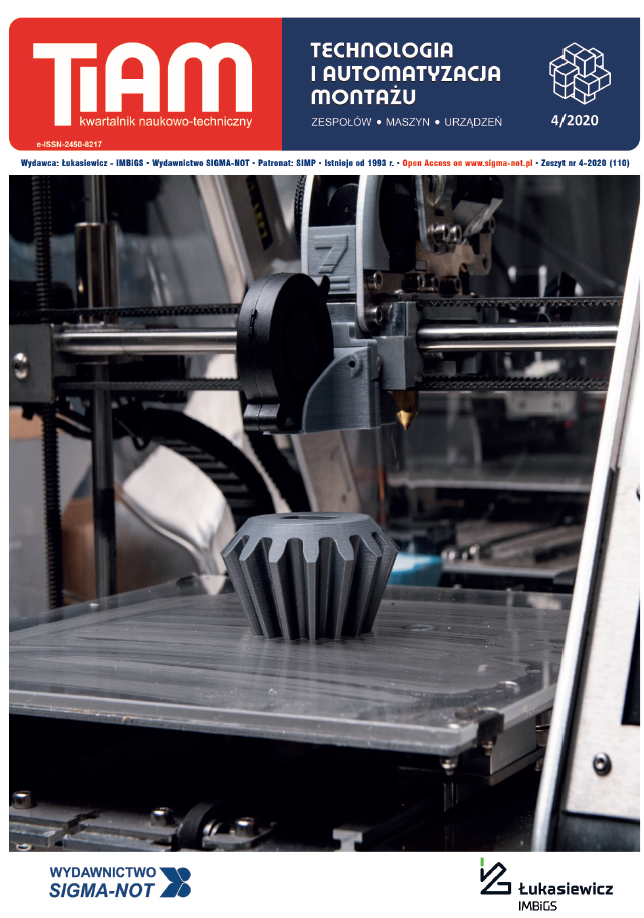Abstract
This paper presents research regarding refill friction stir spot welding (RFSSW) of EN AW-7075-T6 Alclad aluminium alloy sheets, and the joint behaviour under static and dynamic loads. Single-point lap joint of sheets with different thicknesses, which corresponds to those used in aircraft fuselage structures, i.e. upper sheets with a thickness of 1.6 mm and lower sheets with a thickness of 0.8 mm, were analysed regarding the failure mechanism in static shear testing. It has been shown that a properly made joint is destroyed as a result of tension in the lower plate. The lower plate at the edge of the weld is structurally weakened
by the HAZ, but also geometrically due to plastic deformation during the welding process, which has been demonstrated by metallographic investigations as well as by the FEM numerical model. Single-row RFSSW welded joints with different spacing of the welds and a riveted joint were impact tested. It has been shown that welded joints are characterized by a greater stiffness, which is higher when the spacing of the welds is smaller.
This is an Open Access article distributed under the terms of the Creative Commons Attribution License CC BY 4.0 (https://creativecommons.org/licenses/by/4.0/)
References
Bryan H. 1999. Engineering Composite Materials. London: The Institute of Materials.
Cantwell W.J., Morton J. 1991. “The impact resistance of composite materials – a review”. Composites 22(5): 347-362.
Chen Z.M., Kim H., DeFrancisci G.K. Experimental and Modeling Investigation of Blunt Impact to Stringer Reinforced Composite Panels. COVER SHEET.
DeFrancisci G.K., Chen Z.M., Kim H.: Blunt impact damage formation in frame and Stringer stiffened composite panels. 18th International Conference on Composite Materials.
Elber W., Shivakumar K.N., Illg W. 1985. “Prediction of low velocity impact damage in thin circular laminates”. American Institute of Aeronautics and Astronautics Journal 23(3): 442-449.
International Air Transportation Association. 2005. Ground Damage Prevention Programme Targets 10% Cost Reduction. Industry Times, Article 4.
ISO 6892-1:2016. 2016. Metallic materials — Tensile testing — Part 1: Method of test at room temperature. Switzerland, Geneva: International Organization for Standardization.
Kim H., Kedward K.T. 2000. “Modeling Hail Ice Impacts and Predicting Impact Damage Initiation in Composite Structures”. AIAA Journal 38(7): 1278- 1288.
Kim H., Kedward K.T., Welch D.A. 2003. “Experimental Investigation of High Velocity Ice Impacts on Woven Carbon/Epoxy Composite Panels”. Compo¬sites Part A 34(1): 25-41.
Kubit A., Bucior M., Wydrzyński D., Trzepieciński T., Pytel M. 2018. “Failure mechanisms of refill friction stir spot welded 7075 – T6 aluminium alloy single – lap joints”. International Journal of Advanced Manufacturing Technology 94(9-12): 4479-4491.
Kubit A., Kluz R., Trzepieciński T., Wydrzyński D., Bochnowski W. 2018. “Analysis of the mechanical properties and of micrographs of refill friction stir spot welded 7075 – T6 aluminium sheets”. Archives of Civil and Mechanical Engineering 18(1): 235-244.
Kubit A., Kluz R., Trzepieciński T. 2020. “A fully coupled thermo mechanical numerical modelling of the refill friction stir spot welding process in Alclad 7075 T6 aluminium alloy sheets”. Archives of Civil and Mechanical Engineering 20(117): 1-14.
Mendez P.F., Eagar T.W. 2001. “Welding process for aeronautics”. Advanced Materials and Processes 159: 39-43.
Niewerth D., Stefaniak D., Hühne C. 2014. The response of hybrid composite structures to low-velocity impact. 16th International Conference on Experi¬mental Mechanics.
Richardson M.O.W., Wisheart M.J. 1996. “Review of low-velocity impact properties of composite materials”. Composites Part A: Applied Science and Manufacturing 27(12): 1123-1131.
Safri S.N.A., Sultan M.T.H., Yidris N., Mustapha F. 2014. “Low Velocity and High Velocity Impact Test on Composite Materials – A review”. The International Journal of Engineering and Science 3(9): 50-60.
Schoeppner G., Abrate S. 2000. “Delamination Threshold Loads for Low Velocity Impact on Composite Laminates”. Composites: Part A 31(9): 903-915.
Simufact Forming - Theory manual. 2016. Champa¬ign: Computational Applications and System Integration Inc.
Zbrowski A. 2012. „Bezpieczeństwo samolotów w aspekcie zagrożenia kolizją z ptakami”. Problemy Eksploatacji 2: 215-227.


